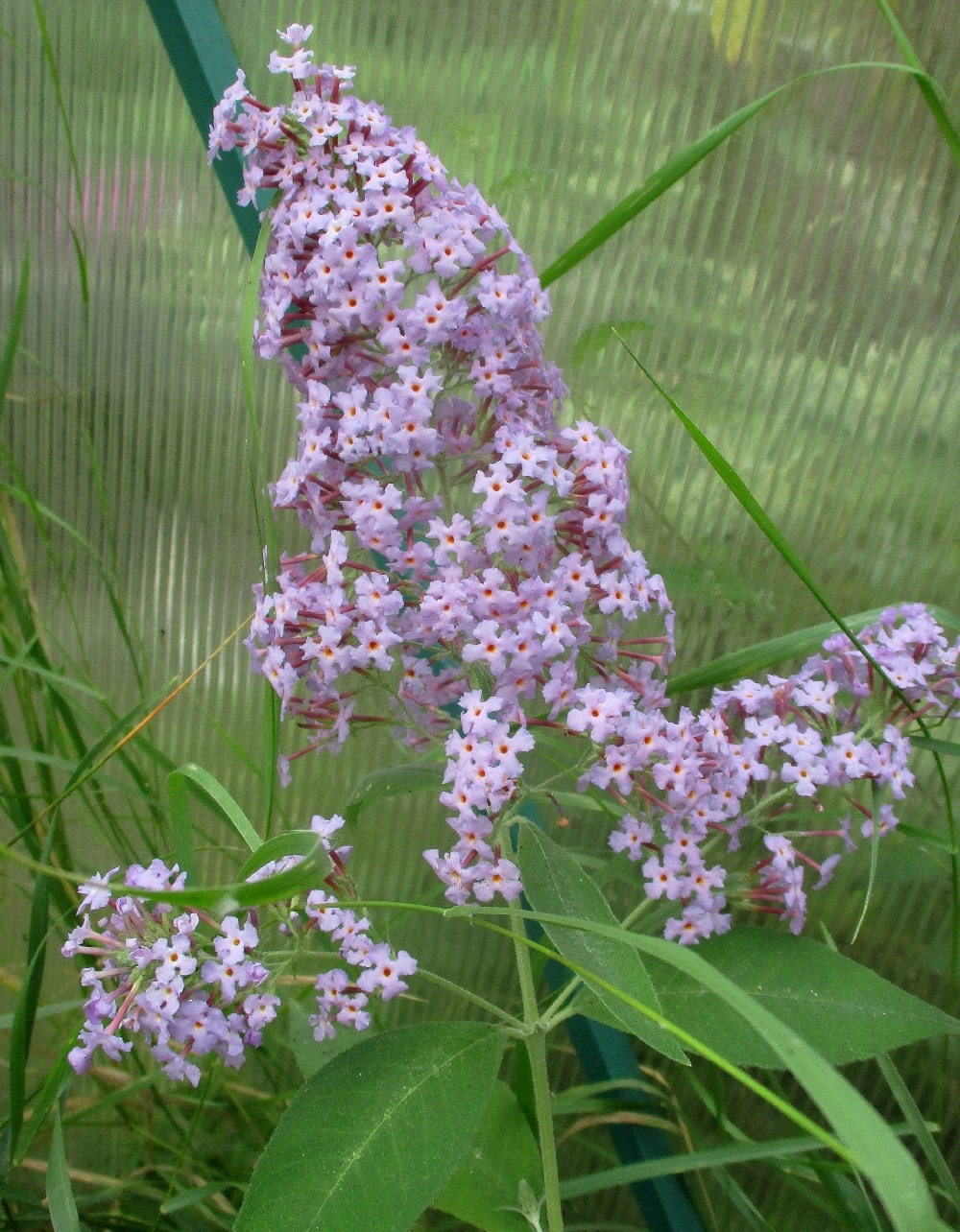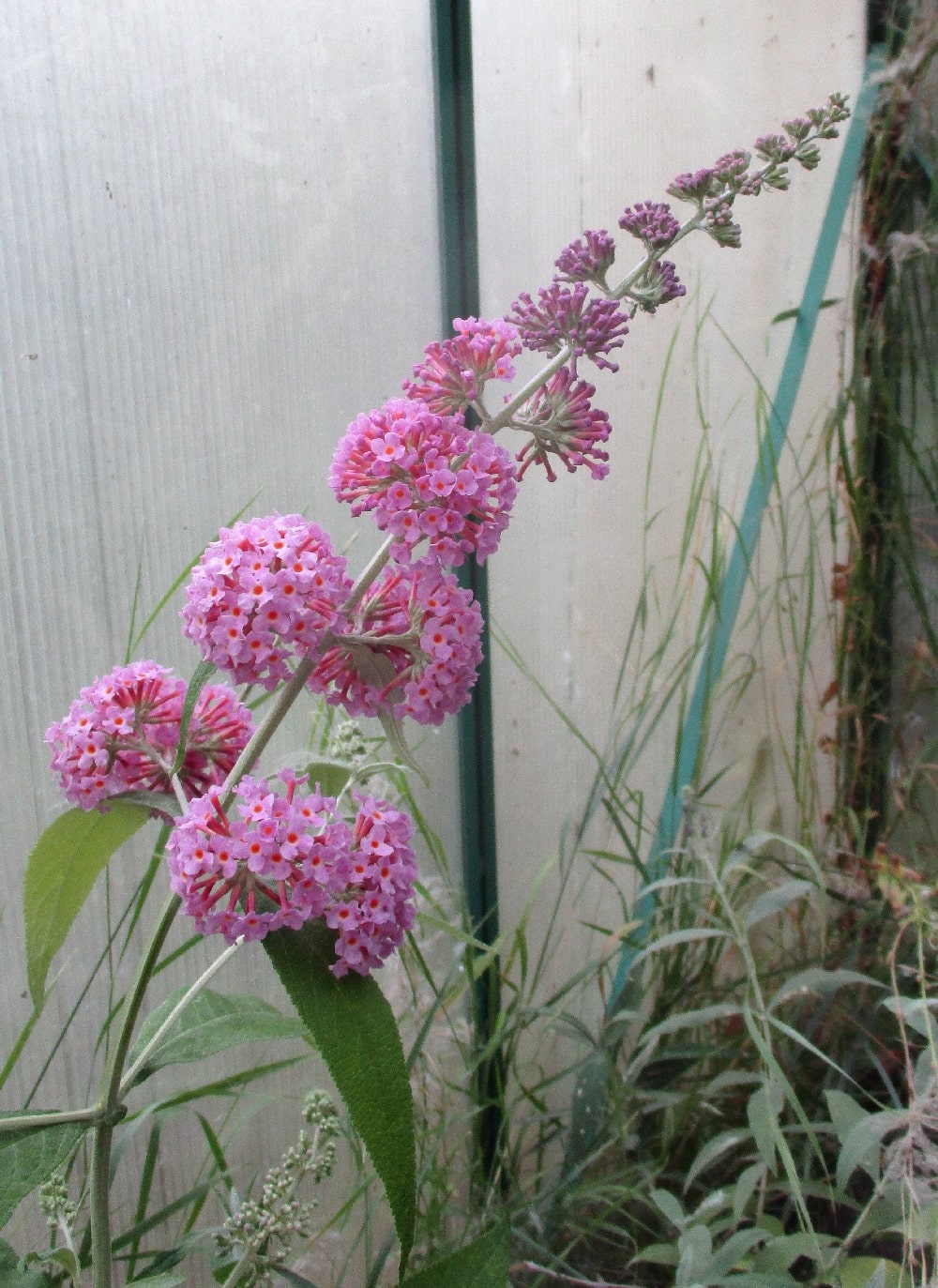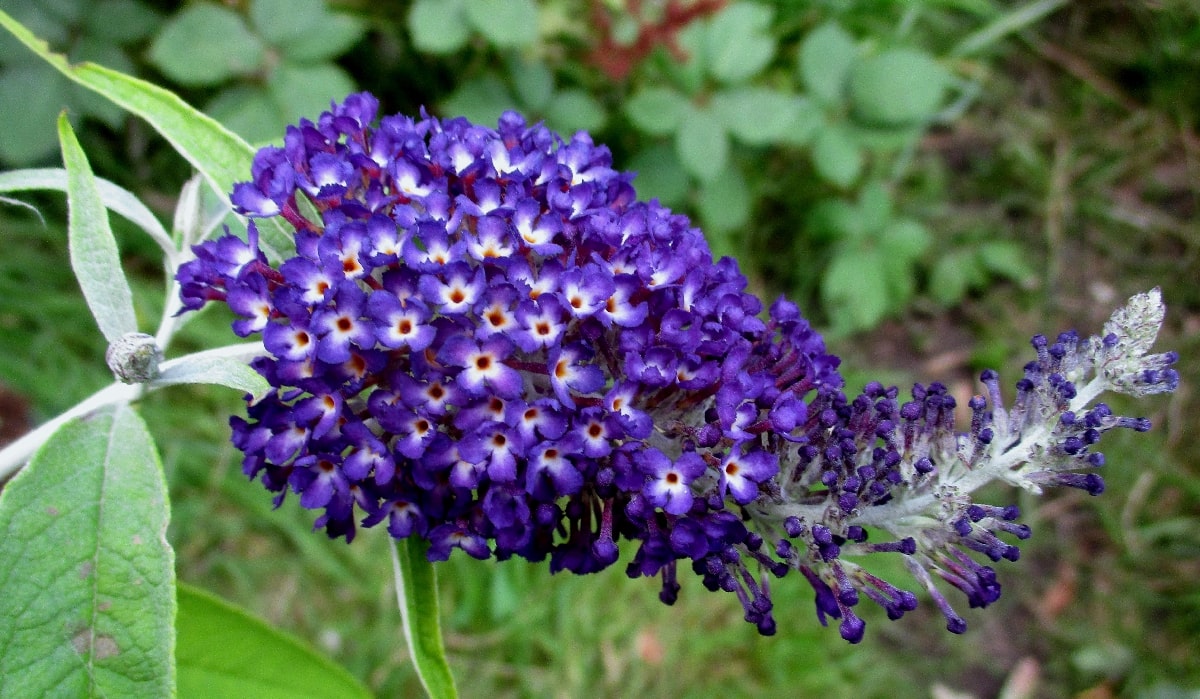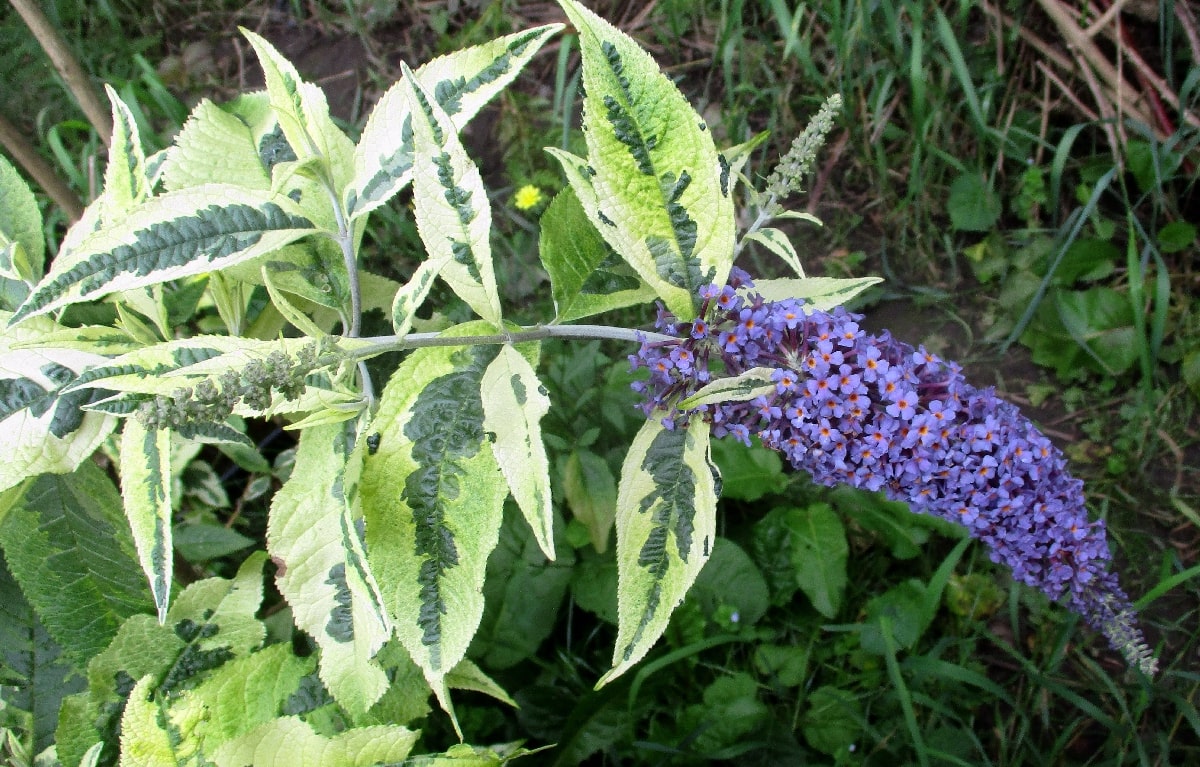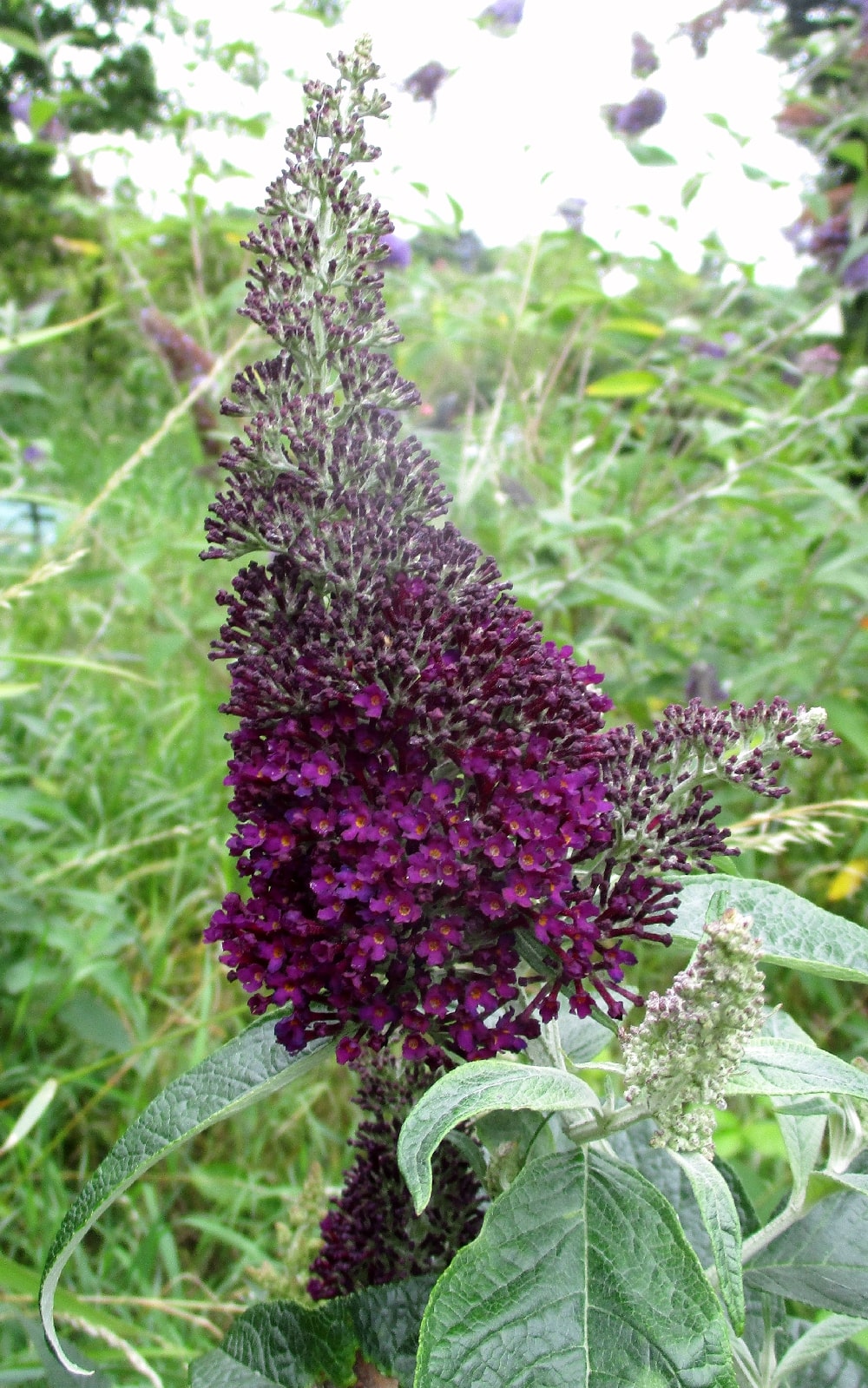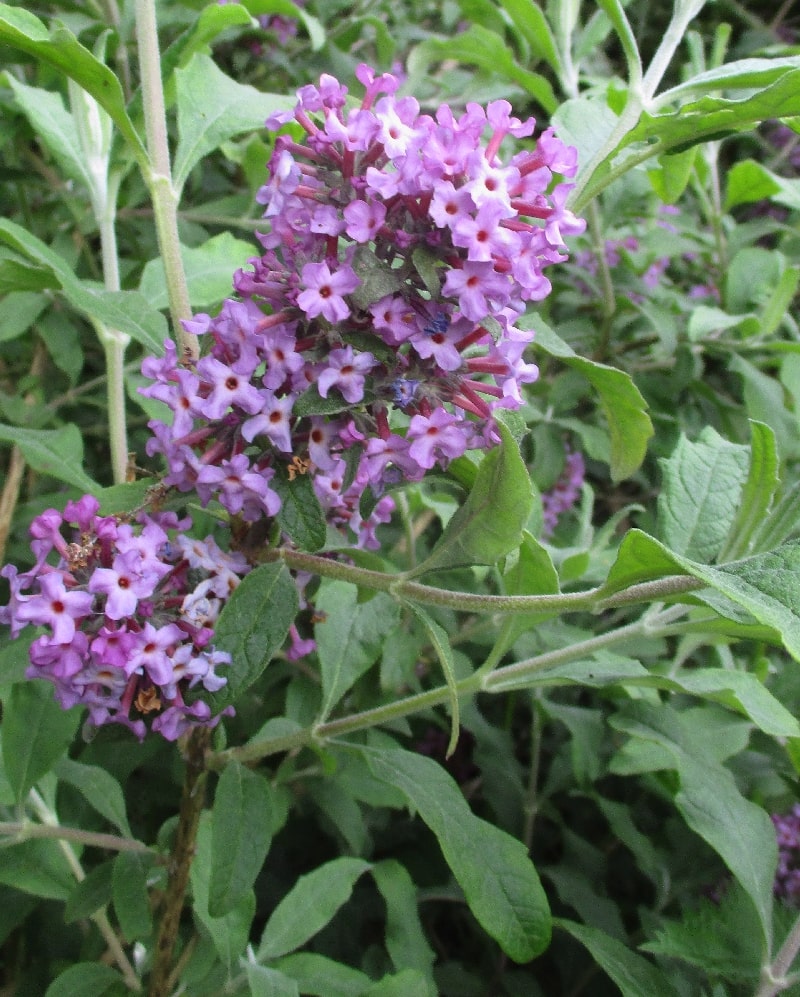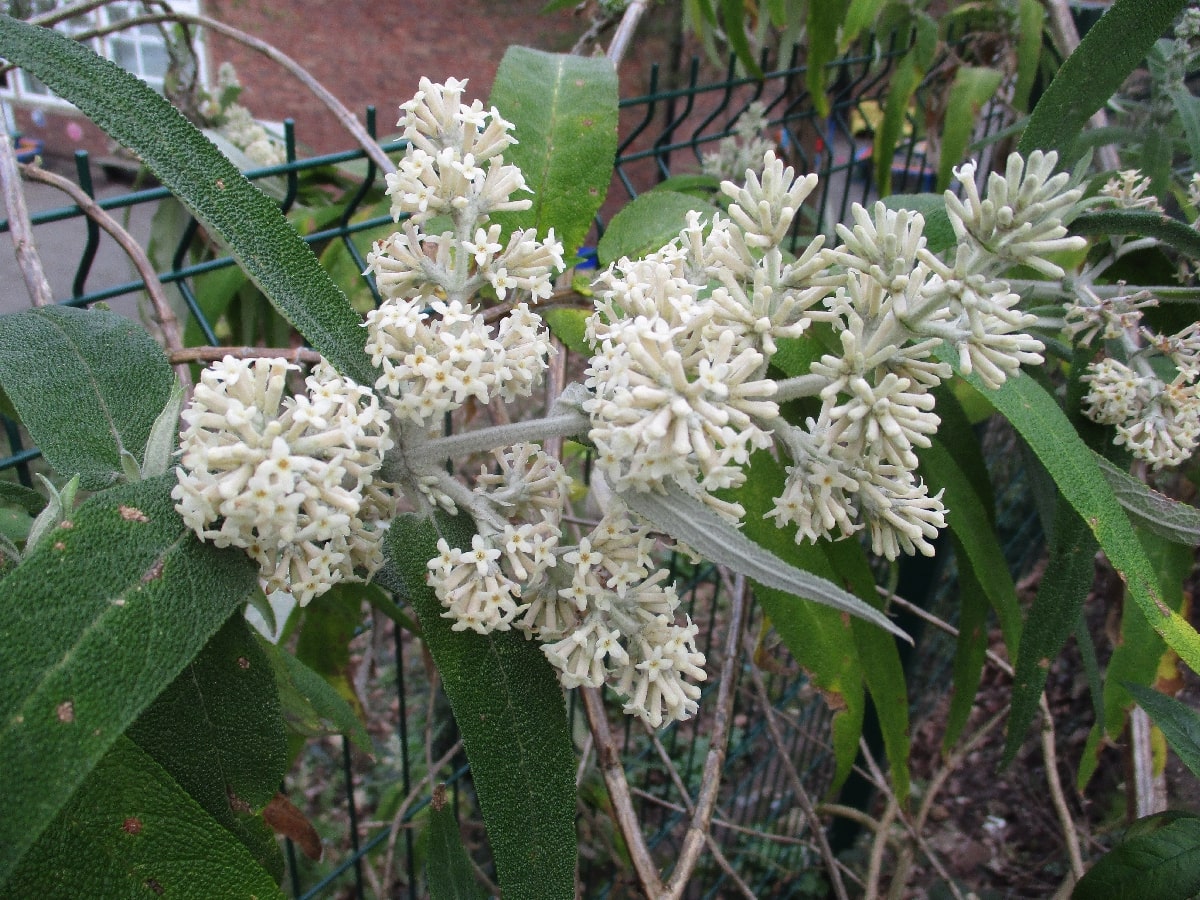
New Page
Pests and Diseases
15th September 2023
I've had my fair share of issues in The Buddleja Garden. From downy mildew killing seedlings, to new cultivars I've been unable to grow because of eelworm, to sawfly larvae munching the flower-buds in my polytunnel. Buddleja are resilient, but not immune to every insect, fungus and virus. So I thought it was about time I created a page listing the common pests and diseases likely to be encountered.
Aphids causing blisters and yellow lesions on the leaves have been particularly common this year. It's not a problem I've seen much of before, and the damage is unsightly. The good news is once the aphids had gone, the new growth was unaffected and the plants recovered completely.
Go to the new PESTS AND DISEASES page.
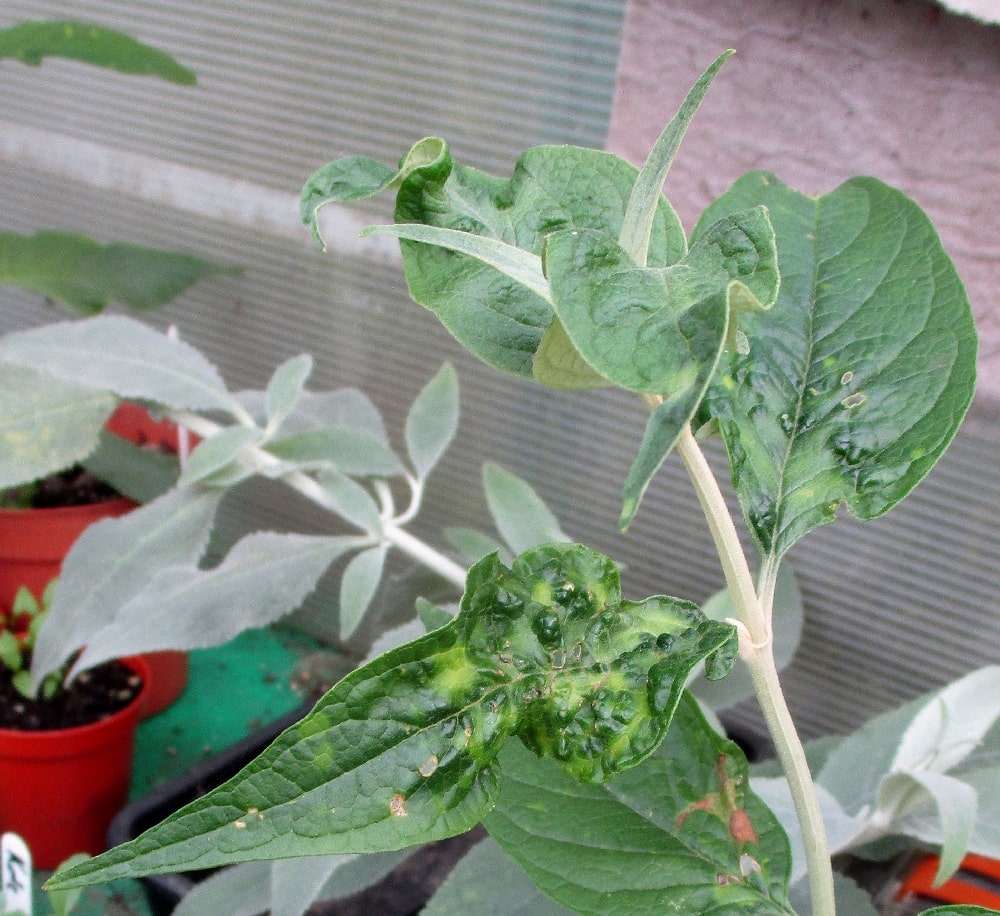
An unidentifed aphid has caused this distortion in the foliage
Open full size image in a new
window
Buddleja
macrostachya
ex situ Seedling
6th September 2023
A few years ago I crossed two dissimilar B. macrostachya plants, GWJ 9286 and RF 040, both from India and both mis-identified as species other than B. macrostachya. There is more about these plants and their identification on a dedicated Buddleja forrestii and Buddleja macrostachya page.
The resulting progeny were a varied bunch, with a mixing of the features from each parent and one or two surprises. I grew both reciprocals (seeds from both RF 040 and GWJ 9286). The biggest surprise was a bright pink-flowered plant arising from the two white-flowered parents. Most, but not all, of the GWJ 9286 seedlings inherited the brown tomentum of RF 040, and also the thicker, broader leaves. The seedlings of RF 040 generally were more like the seed-parent, although some features of GWJ 9286 were obvious enough for me to be confident they represented an out-cross rather than being the result of self-pollination.
I can't plant out and keep them all, so I selected a few to grow on. Obviously, the bright pink RF 040 seedlings is a keeper, especially given how hardy it has proven. I've also selected two of the GWJ 9286 seedlings to grow, selected because they are so dissimilar. The first is much like RF 040, with brown tomentum on the leaves and stems - a feature which has proved fairly dominant. The second, the plant shown, is another outlier.
The leaves have white tomentum like GWJ 9286 and are a similar mid-green. However, they are huge, much larger than seed-parent at up to 30 cm long, and more pendulous than either parent. The flowers are intermediate between the parents, and the inflorescences (the 'panicles') are particularly long, anything up to 40cm in length, and hang down in a long tail-like fashion. This large shrub has a remarkably tropical appearance for a plant which has proven hardy, and after just over a year in the ground is already around 4 metres tall. The vigour is impressive, too impressive for most gardens.
I would like to do some selective breeding of these more unusual Buddleja species, although the investment of time and space would be considerable. The goal would be smaller and more reliable cultivars, garden friendly and with the added bonus of being less invasive than the common B. davidii types.
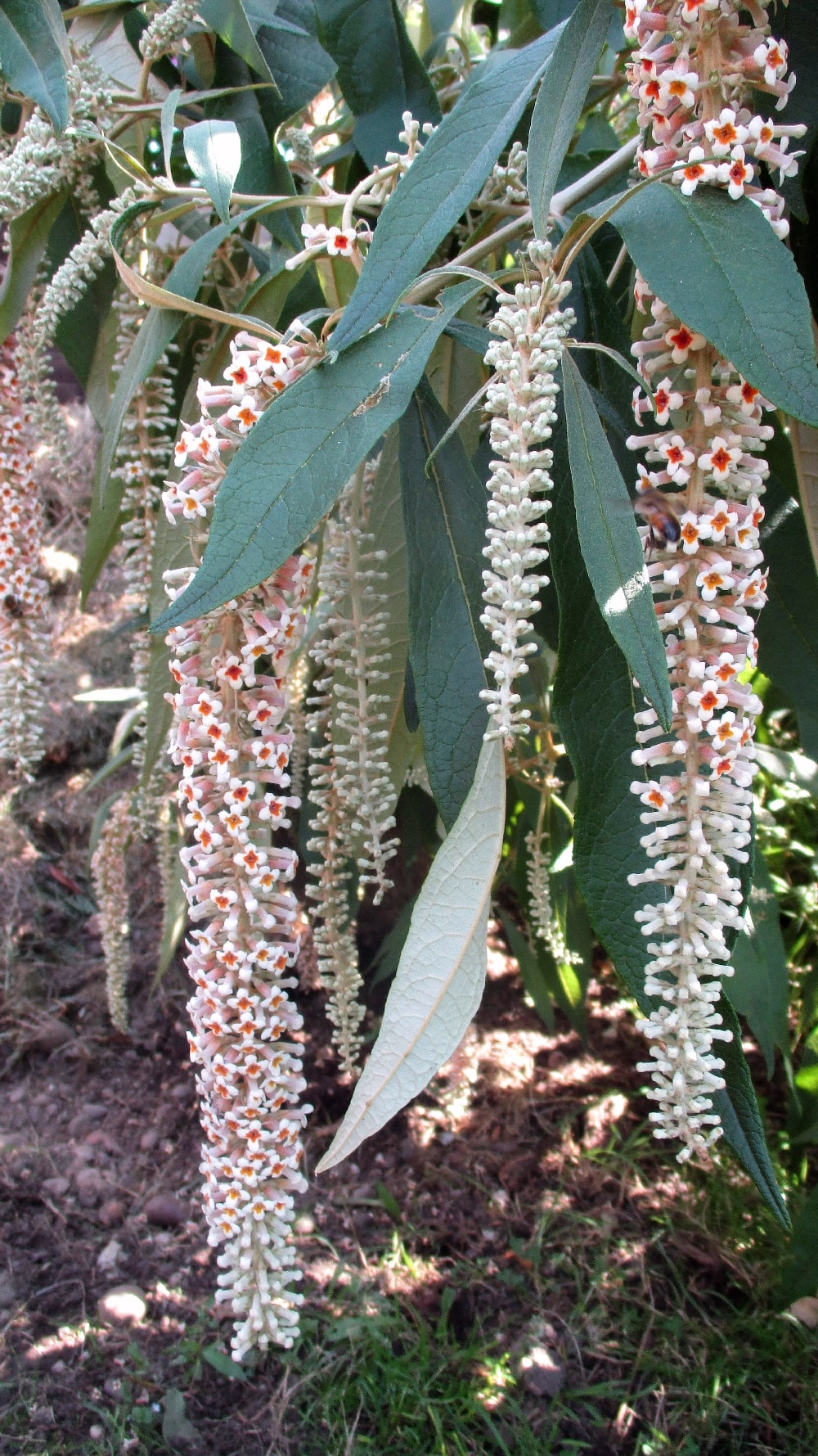
This seedling of two B. macrostachya plants has proven hardy and vigorous, and has spectacular inflorescences
Open full size image in a new
window
Buddleja x weyeriana
Unusual Panicle
30th August 2023
Every once in a while, a plant produces something unexpected. B. x weyeriana 'Honeycomb' has thrown up an anomaly, which I have seen before, of a colourless flower from lilac buds. The area is too localised to propagate a stable sport, but it does raise an interesting possibility about the origin of B. x weyeriana 'Moonlight' . 'Honeycomb' is a superior clone of 'Sungold', which is in turn is a sport of 'Golden Glow'. There is more on these plants on the Buddleja x weyeriana page.
I had always believed 'Moonlight' to be a sibling of 'Golden Glow', a genetically unique plant, but the aberrant flower is so like that cultivar I am wondering whether 'Moonlight' arose as a sport, a shoot with different characteristics, growing out of 'Golden Glow' very soon after the latter's creation by Mr van de Weyer during th First World War.
'Honeycomb' has absolutely no lilac in the buds nor the flower. The lack of anthocyanin is down to suppression rather than the lack of genes to make the colour, and in this case that suppression has been lost for some reason. What is most intriguing is how the lilac has returned in the altered flowers and yet the yellow pigment has all but disappeared. I have long suspected the genetics and chemistry of Buddleja flower-colour are rather more complex than would first appear, and the precise conditions and genetic combinations that led to the various B. x weyeriana cultivars difficult to reproduce.
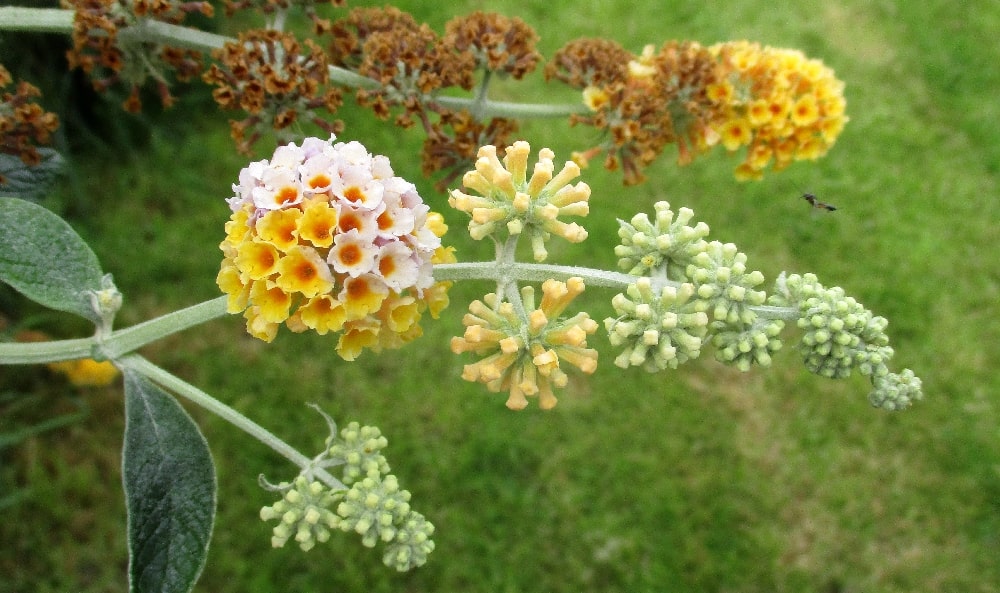
An aberrant flower on 'Honeycomb'
Open full size image in a new
window
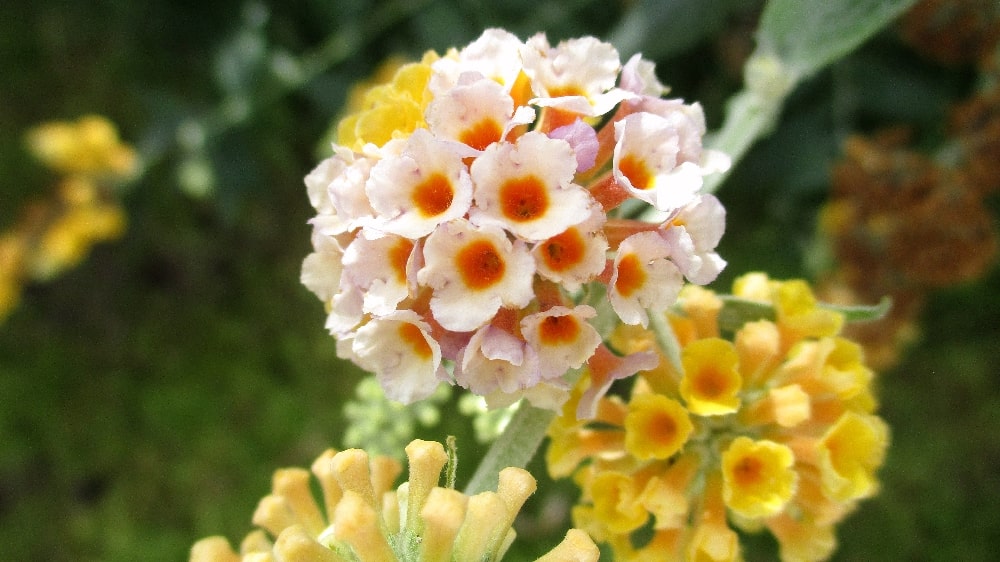
Up close, the lilac is visible
Open full size image in a new
window
'Bressingham Bountiful'
22nd August 2023
There have been very many new Buddleja releases in recent years, although very few have been full-size cultivars. The new 'Bressingham Bountiful' is a 'proper' Buddleja, expected to reach at least 2 metres in height, and comes from Adrian Bloom of Bressingham Gardens in Norfolk. It is currently being propagated by Seiont Nurseries (Gwynedd, Wales), and I'd like to thank the nursery for this trial plant.
Described as a seedling of 'Lochinch', a hybrid of B. fallowiana and B. davidii, 'Bressingham Bountiful' has greyish foliage inherited from this B. fallowiana ancestry. The inflorescences are large and balloon-like; they bear such a resemblance in form to 'Gulliver', I suspect that cultivar might be the pollen parent. The flower colour is a pale lavender-lilac, paler than 'Lochinch', and not very vibrant. The inflorescence size is impressive, even with just a small plant still in a pot, so the mature shrub should go on to produce really impressive panicles of flowers. Hopefully, the stems are going to prove robust enough to support their weight, and withstand the wind and rain.
Perhaps this is the start of a trend away from the ultra-compact hybrids and back towards more natural looking Buddlejas. There is a lot yet be achieved and perfected with the normal sized B. davidii type in terms of foliage, flower type and colour.
Seedling of Buddleja x weyeriana 'Sungold'
18th August 2023
Many texts and websites suggest the Buddleja x weyeriana cultivars are seed sterile. However, if there is a nearby suitable pollen-bearer (usually a B. davidii), they will all produce viable seed. The resulting seedlings are a little tricky to raise, as they tend to be more prone to fungal attack than average. Once grown past the early seedling stage, the plants are usually robust and trouble-free.
There are a number of B. x weyeriana seedlings on the market, 'Bicolor' (syn. 'Flower Power') and 'Pink Pagoda' are possibly the most familiar. (See the B. x weyeriana page for more details.)
I've raised seedlings from all the B. x weyeriana cultivars and been pleased with some of the results. The flower-colour tends to be pastel rather than intense, but the inflorescences are usually large and have an added interest where they consist of a series of very loose balls rising up the panicle. The flowers are never yellow, although some have a hint of the yellow pigment beneath the main colour.
The one shown is out of 'Sungold', and was raised in 2013. I've had it growing outside for a number of years now at the back of a block of similar plants, so have not been able to fully appreciate the flower even though it has grown quite tall. Although pink, the shade is different from the aforementioned 'Pink Pagoda' and the stages of the panicle are more ball-like. The flowering is reliable, from early August onwards; it is seed-sterile, and also most likely pollen-sterile too.
It's time for it to come out of the shadow of its vigorous cousins, so I have started a new plant that can go where I can see it clearly.
The White Ring
16th August 2023
It's not uncommon for a B. davidii flower to have a white ring around the orange eye, and I like the effect. For several years I've been trying to perfect a plant with a dark colour, a neat white ring around the eye and a decent growth habit. So many failures: weak colours, no white ring and, most frustratingly, bad growth habits like laxity and rolling foliage. The one shown is from the latest attempt to perfect the type. A close up shows the extent of the white ring in each individual flower. But everything about the the plant is tiny - short height, small foliage, small individual flowers - almost like a scaled down version. However, when planted out into soil, such plants have a habit of finding more vigour.
High Five Purple
Syn. 'Podcept1'
10th August 2023
Recent years has seen a surge in Buddleja releases, mostly of the diminutive kind. I've lost count of the number of series and individual cultivars that promise everything possible and all in a plant bred to be small, less than a metre height and spread. These claims rarely, if ever, prove true. I can only try a handful of the new ultra-compact cultivars, but so far not one has impressed.
'High Five Purple' (also known as 'PODCEPT1') is a plant from Peter Podaras in America, a breeder also responsible for the extensive FLUTTERBY® group of Buddleja hybrids. The plant is billed as being ultra-compact, with large inflorescences made up predominantly of doubled flowers. Given how tiny the average Buddleja flower happens to be, the effect of doubling is going to be underwhelming.
In my experience, 'High Five Purple' actually produces very, very few genuinely doubled flowers, with most being single or with only a small extra petal in the throat. The colour is far from purple, more of a dull pinkish-mauve, although the panicles are quite large for the size of plant and upright. The plant has remained small, about 40cm tall, hardly surprising since I've never been confident enough in its robustness to grow it outside - it's spent its life cosseted in a pot and mostly undercover. The foliage has proven prone to botrytis (grey mould), and is pretty badly scarred.
Nurseries in the UK seem to have given up on 'High Five Purple' already and most outlets that have it listed show it as out-of-stock. I'm not surprised, as it's a poor grower. The novelty of the occasional double-petalled flower does not make up for its many shortcomings.
Having lost any number of these ultra-compact Buddleja to disease or the elements, I'm beginning to wonder if they serve any purpose for the gardener. Once taken from the greenhouse, most start to look stressed and windswept. They show little resistance to pathogens and pests, and seem suited only to container growing. I predict all but a handful of those currently on the market will be gone in five years, to be replaced by another short-lived cohort. I doubt I'll be trying any others in the near future
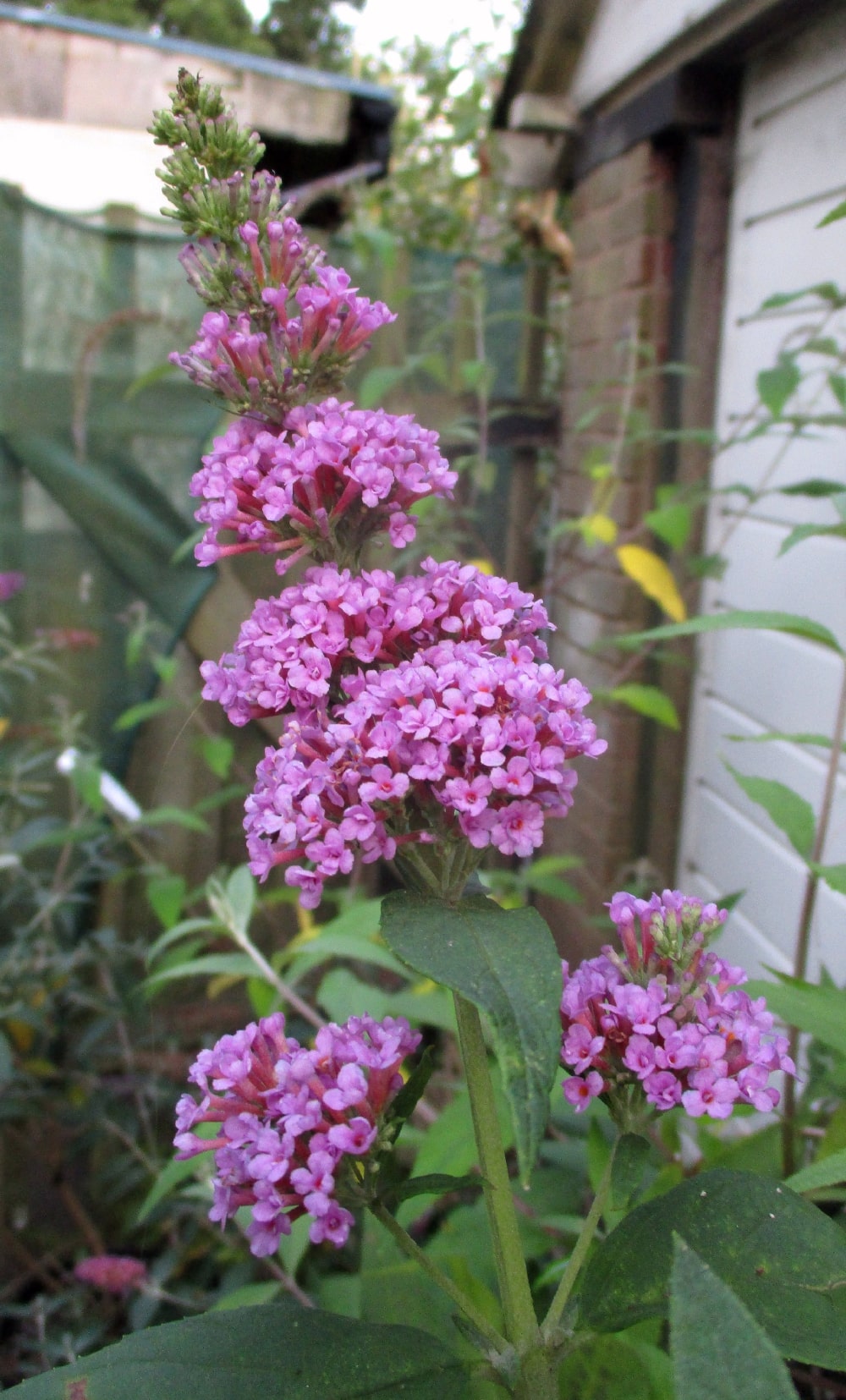
'High Five Purple' is supposed to have double flowers, but in practice
very few are fully doubled.
Open full size image in a new
window
'Butterfly Gold'
5th August 2023
I have planted 'Butterfly Gold', a recently released variegated cultivar, out in the ground to see how well it performs - life in a pot is no indicator of garden worthiness. Thus far it's looking good, establishing well and flowering now. And no sign yet of any reversions. The variegation is quite deep, wide cream-white margins, and the plant remains reasonably vigorous. The flowers are more of a blue shade, and not pale violet like 'Burncross' and 'Variegata' (syn. 'Florence'). Thus far, it seems an improvement on those two, which both have their issues. 'Burncross' is delicate plant with very small flowers, and difficult to propagate. 'Variegata' grows well at first, but becomes sparse and leggy when it matures. Hopefully, 'Butterfly Gold' will outperform them both.
Buddleja myriantha W/O 9270
3rd August 2023
Until recently I hadn't seen an authentic Buddleja myriantha. Bizarrely, in the horticultural trade the name has been attached to B. salviifolia, B. curviflora and even a gracile form of B. macrastachya, none of which bear the slightest relation or similarity to the genuine article. It's a species rare in cultivation, but I was finally able to obtain an actual B. myriantha from the Royal Botanic Gardens Edinburgh, collection H&M 1520.
And then I obtained seeds from China, collection W/O 8047. The forms of the seedlings varied slightly, mostly as to flower colour, and all were somewhat different to the Edinburgh plant. The flowers are minuscule, on one particular plant the flowers are perhaps only 2-3 mm in diameter (B. davidii typically has flowers 7-8 mm in diameter). A year later and I was growing yet another collection, W/O 9270. Again, there are a number of variants in the collection, but the one shown is most interesting with its pale lilac flowers, each about 4-5 mm across. It has a very short and dense growth habit, whereas its siblings vary from upright to practically creeping along the ground.
In the second photo, note the ridged rhachis (central stem of the inflorescence), a feature common to all the members of this species I've grown.
The species is mostly known from Yunnan (China), with a few reports from northern Myanmar too. All three collections I'm growing come from the Cangshan (Dali, Yunnan), and are from slightly different altitudes. The species is highly variable, even in my small sample size, and this despite its restricted range.
B. myriantha is unlikely to take off as a popular garden plant with such tiny flowers. Probably one for the completist or enthusiast.
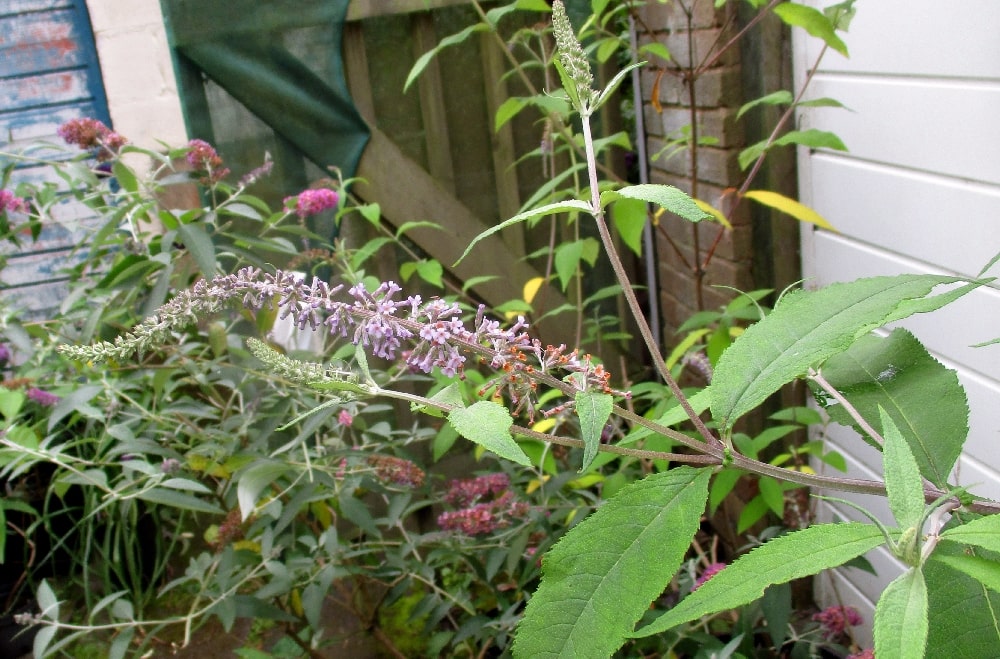
B. myriantha W/O 9270, an example with lilac flowers.
Open full size image in a new
window
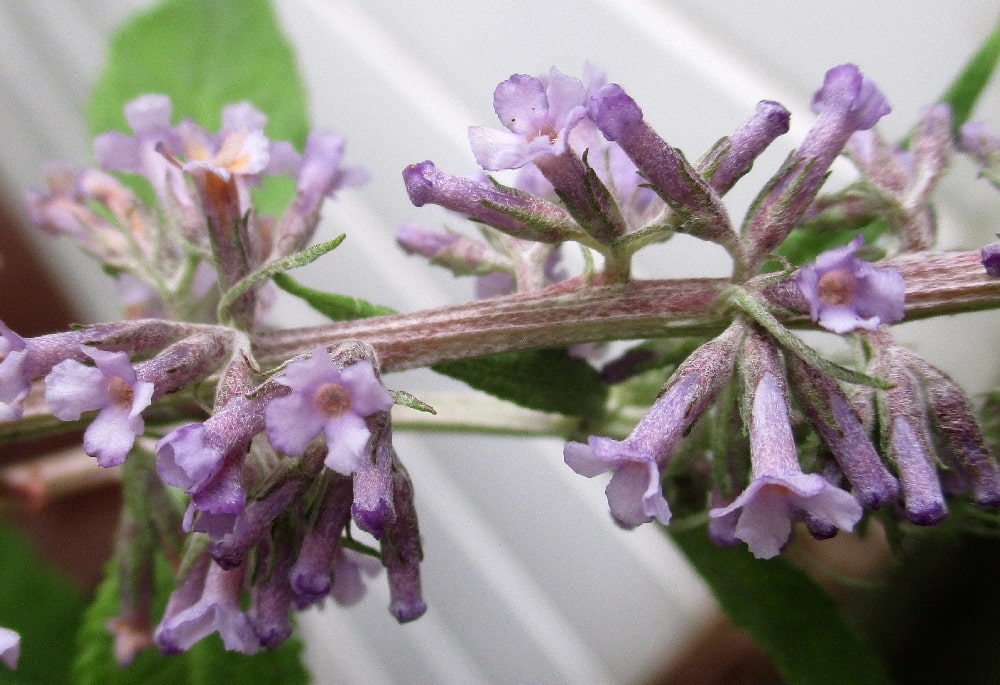
W/O 9270 up close, typical B. myriantha flowers
Open full size image in a new
window
MONARCH® Dark Dynasty
22nd July 2023
The MONARCH® series of smaller Buddleja comes from Walters Gardens Inc. (Michigan, USA). These hybrids, based mostly on B. davidii, are smaller but not extremely compact, growing to roughly 1.5m in height and spread - similar in size to the BUZZ® plants. There is a sister series, also from Walters Gardens, called HUMDINGER®, which are claimed to be much smaller. Originally developed for the North American market, several have since been introduced into Europe and were being grown in the UK by Allensmore Nurseries (Herefordshire). The MONARCH® series consists of: 'Blue Knight' (light lavender purple); 'Crown Jewels' (magenta purple with yellowish foliage); 'Dark Dynasty' (deep purple); 'Glass Slippers' (pale violet); 'Prince Charming' (bright cerise-pink); 'Princess Pink' (pale pink); 'Queen of Hearts' (magenta).
Bold claims are made for these plants: stupendous colours, wondrous flowering performance, and perfect growth habits. Hyperbole possibly; the reality tends to be a little more modest. So I like to try out these plants for myself, and have planted a 'Dark Dynasty' on my plot.
Planted this spring, it has grown to about a metre in height; 'Dark Dynasty' looks like could get bigger with time. The growth habit seemed quite open and it was doing okay until this weekend's wind and rain, which has all but flattened it, the stems too weak to hold up the wet, heavy inflorescences. I remain optimistic the plant will become more sturdy with age and more dense in habit - time will tell whether the plant is actually any good or totally unsuited to real-world conditions. The flower panicles are rather short, but they are fat and densely packed. The flowers themselves are genuinely dark, and similar to the rival BUZZ® 'Wine' in colour. However, the colour is a little unstable and the initial red-purple is less intense, duller and bluer, at the edges as the flowers age. It's also one of those shades whose appearance varies in different lights. That said, the flowers are pretty good overall.
I don't think the MONARCH® or HUMDINGER® ranges have been an overwhelming success commercially in the UK, and my information is that Allensmore is no longer producing these plants, with the possible exception of 'Prince Charming'.
Buddleja forrestii W/O 7061
19th July 2023
W/O 7061 is a Buddleja forrestii collection raised from seed collected in south Sichuan (Liangshan, at 2775 metres above sea-level) by Chinese Alpines, and I have kept several siblings. At first, the seedlings looked identical, although when they finally bloomed the flower-form showed some variation. The colour has generally been white, differing slightly in the shading present at the opening or the senescing of the flower. This collection should be reasonably hardy according to its origin and able to withstand an English winter, so I have been growing them outside without protection. They have proved robust and evergreen, with all the W/O 7061 plants coming through last year's harsh winter intact.
The one shown is somewhat confusing. The first time it flowered was in late autumn under cover and the corolla tube appeared sufficiently long, cylindrical and tomentose for me to be initially convinced it was B. macrosachya rather than B. forrestii - the two species can be hard to tell apart and they share habitats. Last year the drought affected its ability to establish in the ground and to flower, so I've had to wait until now for the established shrub to flower well and, more importantly, true.
I think my initial impression was incorrect. Firstly, the flowering time is now and a little too early for B. macrosachya, and coincides exactly all the other B. forrestii collections I am growing. Secondly, close examination of a dissected flower shows how the stigma is virtually level with the stamens, a feature I have found to be a very reliable indicator of this species. On the other hand, the exterior of the corolla tube is slightly tomentose and the ovary significantly tomentose on the upper half, features I might normally associate with B. macrostachya, although these features can on occasion be found with B. forrestii. Finally, the stems are significantly winged, and I've found this to be a little more common in B. forrestii. So on balance, and given how the rest of the collection is unambiguously B. forrestii, I am reasonably certain it is that species. I also don't believe it to be a hybrid or intermediate form.
In any case, it's a good plant and I like the way the flowers point downwards. I think it might be a keeper.
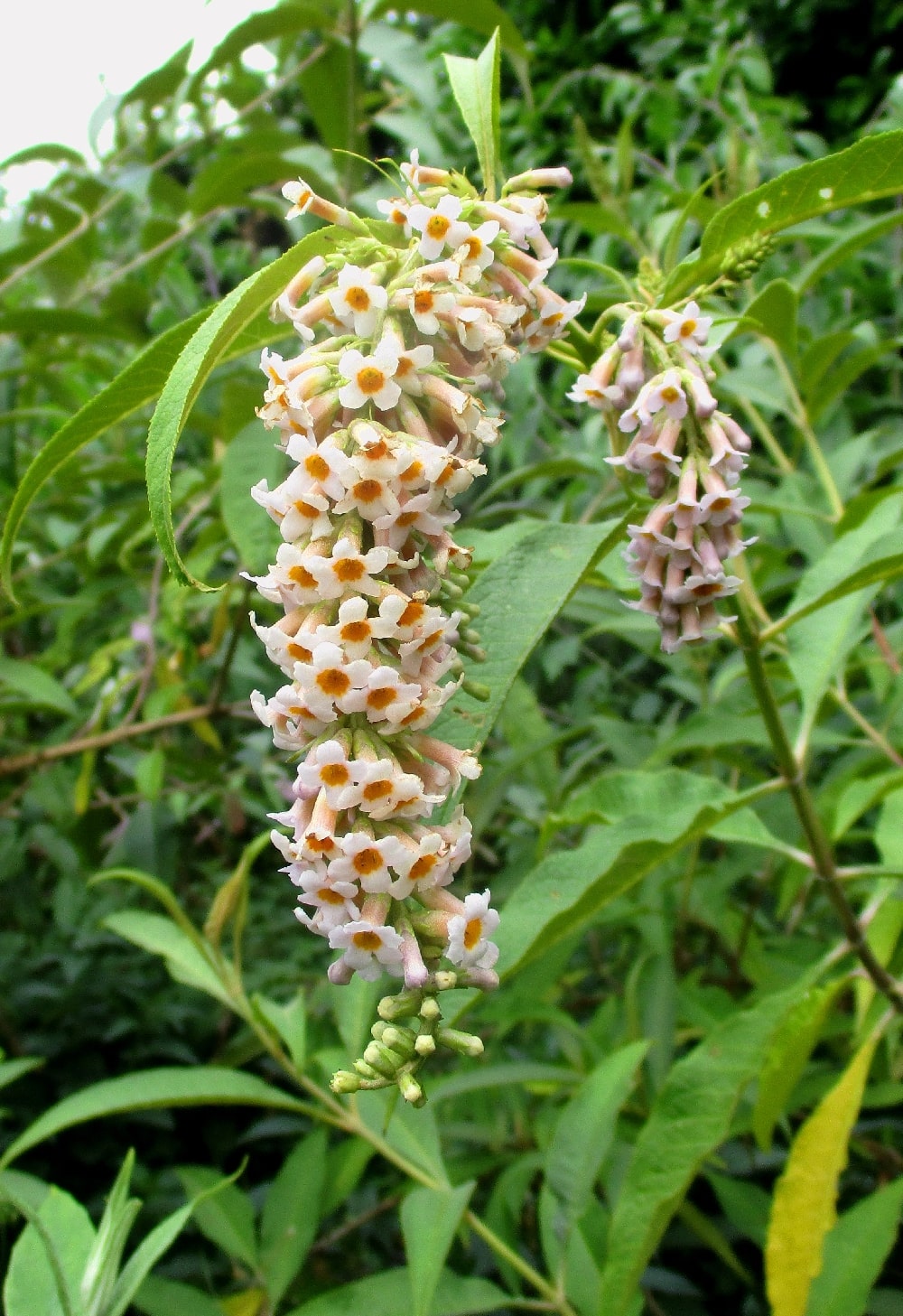
An example of Buddleja forrestii W/O 7061, one of several
seedlings I've kept.
Open full size image in a new
window
Buddleja fallowiana
Hybrid
12th July 2023
Last time I wrote about Buddleja fallowiana BWJ 7803, a rather delicate plant with pale lilac-mauve flowers. Although I've had difficulty keeping this particular plant alive, it has proven relatively easy to hand pollinate, producing plenty of viable seed. B. fallowiana hybridises readily with all cultivars of B. davidii.
I have repeatedly raised hybrid seedlings of the white form of the species (B. fallowiana 'Alba') and had some success, and also raised an F2 generation. They have all done rather well, being more hardy and more robust than B. fallowiana. Some have so-called hybrid vigour, like the AGM awarded Buddleja X 'West Hill', itself a hybrid of the same two species. Unlike the rather insipid flowers of the current hybrids ('West Hill', 'Lochinch', 'Bishop's Violet'), several of the plants I've raised have intensely blue flowers.
When it came to hybridising BWJ 7803, I chose to use several of my own deep blue and purple plants. The resulting seedlings grew well and were not at all delicate. I didn't force them into flower the first year, so they are flowering now at about 18 months of age. The initial results are looking quite promising, with significantly darker flowers than existing hybrids. The one shown has good purple flowers and is quite robust.
The F1 generation doesn't have foliage as grey as the species; as a rule, the better the flower-colour, the less glaucous the foliage. I am hoping to have a couple of good hybrids from this generation to cross, and maybe the F2 foliage will tend towards the species. I've already crossed existing hybrids of my own with BWJ 7803, plants which will be three-quarters B. fallowiana and these seedlings are coming along nicely, although I don't expect flowers until this time next year.
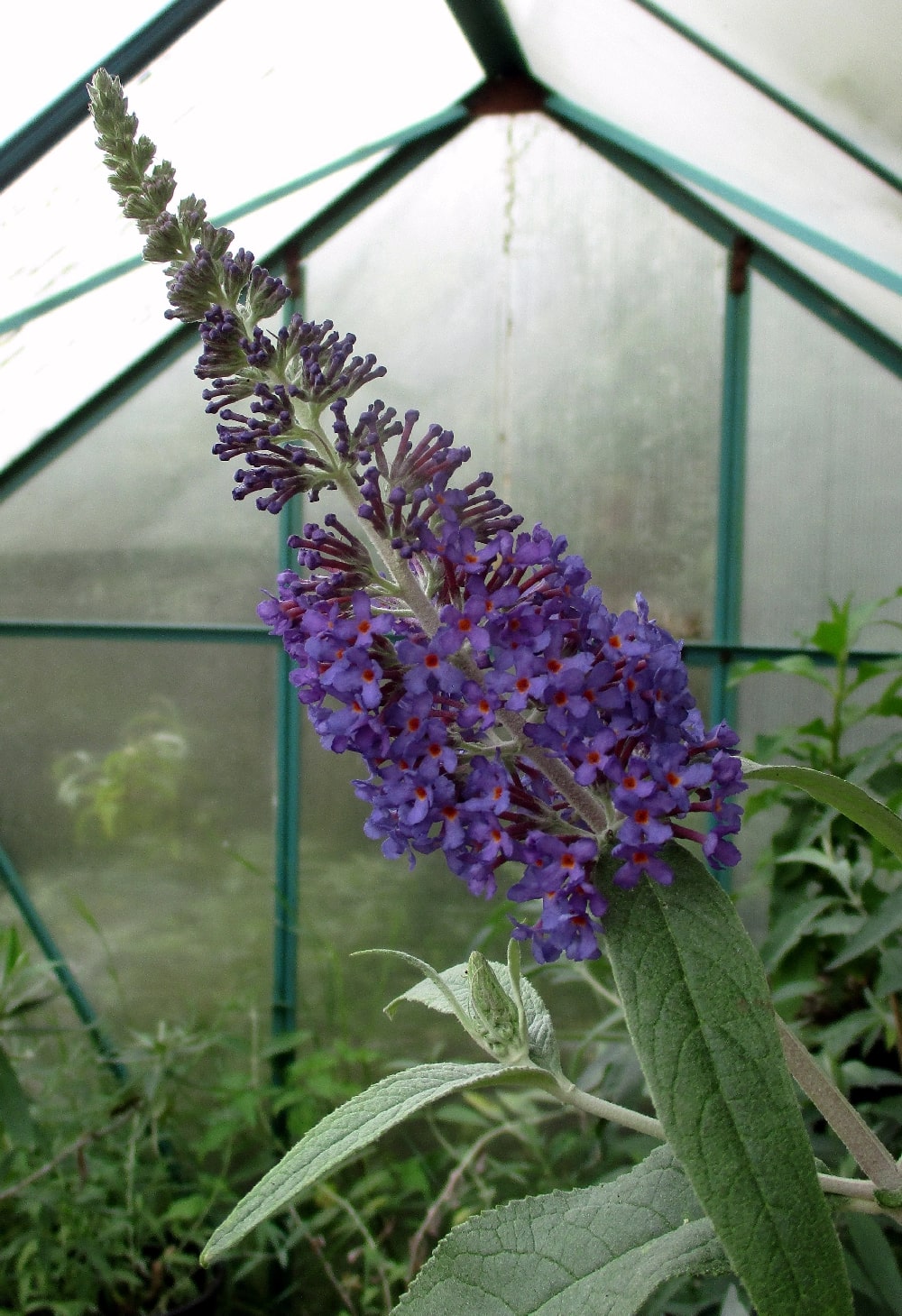
This hybrid of Buddleja fallowiana BWJ 7803 has much darker flowers than the parent
Open full size image in a new window
Buddleja fallowiana
BWJ 7803
5th July 2023
Buddleja fallowiana is a Chinese species very similar to B. davidii, differing mainly in the greyer, more tomentose foliage of B. fallowiana. The two species are so close they hybridise easily to produce fully fertile offspring and several garden cultivars are derived from such hybrids.
B. fallowiana BWJ 7803 comes via Crûg Farm in north Wales, a nursery renowned for its unique plants collected from the wild by its owner, Bleddyn Wynn-Jones. This particular Buddleja, with pale lilac-mauve flowers, was collected from Lijiang in northwest Yunnan (China) and has proven a very delicate plant, far less robust than either the pale blue or the white forms of the species I am growing. In fact, the plant shown is a cutting from a cutting I took from the original plant I bought back in 2019. The roots seem to wither away in winter, even when kept relatively dry and under cover, and fail to regrow come spring. I've yet to successfully grow a fully mature specimen.
I have tried crossing B. fallowiana BWJ 7803 with B. davidii, specifically with dark purple cultivars, and have a small number of seedlings growing. These seem to have hybrid vigour and have come through the winter successfully. I'm waiting for them to flower now and hopefully I'll have a hardy hybrid or two worth keeping.
As for the plant itself, unless I can keep one alive for at least a few years I may have to give up on it. I simply don't have the time to mollycoddle plants too weak to survive my local conditions. Fortunately the pale blue form, B. fallowiana P&M 181, is far more robust and a fine example of the species.
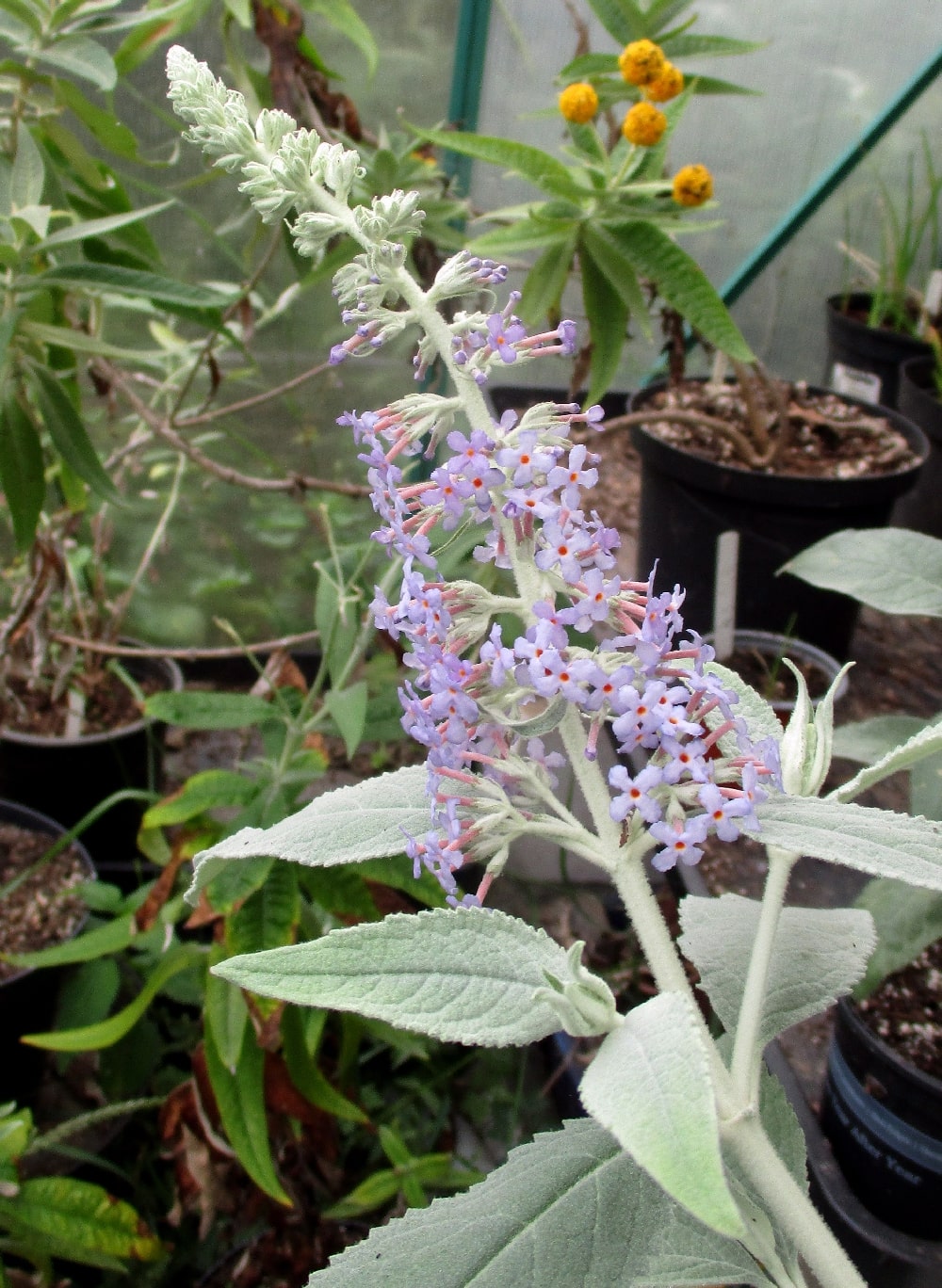
This collection of Buddleja fallowiana, BWJ 7803, has proved tricky to maintain.
Open full size image in a new window
Buddleja nivea C&H 7039 (F2)
22nd June 2023
This plant was raised from the seed of C&H (Cox and Hutchison) 7039, a plant collected from South Sichuan (China) in 1995 and growing at Benmore Botanic Garden in Argyllshire. C&H 7039 is almost certainly self-fertile. The leaves of its seedlings are large, toothed and felted, and overall the plant conforms to the type Buddleja nivea var. yunnanensis. This variety or subspecies flowers a month or more ahead of the species, in early June, and shouldn't be spring-pruned as this will remove the latent flower buds. It's proving a strong grower and fully hardy, and I suspect the mature plants will be very big.
Although true to species and identical in all other respects, the two seedlings I have raised have slightly different flowers. Self-fertile plants do not produce clones of themselves; instead they are pollinated by their own pollen. If the genome carries a lot of variation, and this species-type is highly polyploid, then the resulting progeny can be quite varied due to the multi-copy genes being shuffled into new combinations.
This one has faded pink flowers and the panicles are relatively upright, whereas its sibling has flowers of a more purple hue and the panicles are more lax. A close-up of the flowers shows typical B. nivea features: short funnel-shaped corolla tubes with hairs in the throat, and most of the flowers parts are tomentose. Compared to the flowers of the other seedling , the individual flowers also differ slightly in shape; the petals of the pink-form are straight and flat, whereas those of the purple-form are more contorted.
I doubt this plant would win any beauty contests, although it is interesting enough to be worth preserving as an alternative example of a type rare in cultivation.
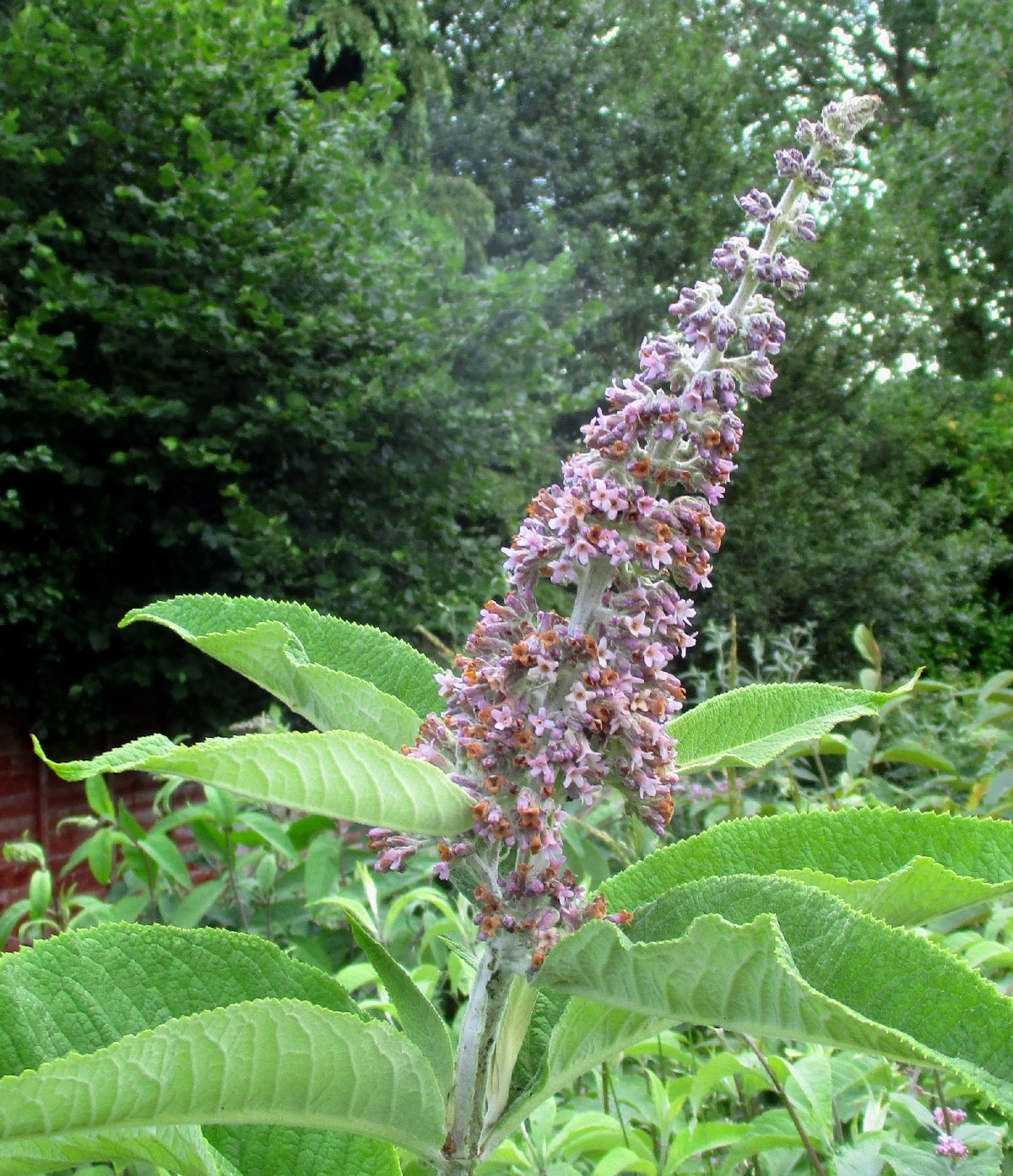
This example of Buddleja nivea var. yunnanensis C&H 7039 (F2) has faded pink flowers
Open full size image in a new window
A New Buddleja Globosa
7th June 2023
Line-breeding can be a tricky business. As well as fixing the traits you want, undesirable features can be reinforced too. B. globosa HCM98017, a male plant, is unusual for the species, because it has very pale green-yellow flowers. But the flower-balls are small and easily overlooked, and it lacks the vigour of the more usual orange-flowered forms. So line-breeding with this plant comes with the risk of weak descendants.
B. globosa is easy to germinate and the seedlings grow well over the summer. Come winter, they become prone to root-rot unless kept dry, and botrytis unless kept with a good air-flow. If they do really well, they might just flower in the first spring; generally, you must wait two years for the first flowers. Breeding new varieties of this species involves patience and not a few failures along the way.
I was very lucky to get a couple of good custard-yellow flowered offspring using HCM98017 pollen. 'Kevin', the male, and 'Beryl', the female, are both strong, vigorous growers and very floriferous. I had to be certain they were worthy before attempting another generation.
My new cultivar is a seedling of 'Beryl' back-crossed to HCM98017. I have exactly what I was aiming for - primrose-yellow flowers. More importantly, the plant appears healthy and vigorous. Comparison with a flower of HCM98017 shows the improved colour and how the balls are somewhat larger.
Flower-colour in B. globosa does not follow typical Mendelian patterns of dominant vs. recessive or incomplete dominance: such a pattern would produce only either pale yellow or custard-yellow plants in this back-crossed generation. Instead the colour seems to be on a continuous scale; this suggests to me that there are multiple copies of the genes responsible for the flower pigment (or their suppression) and the various shades are down to a gene-dosage effect.
B. globosa does badly in a pot long-term, and so I need to get this planted out on my plot before anything goes wrong. If it does well, I think it might have some commercial value and I'll have to give it a name. As it's male, 'Simon' might be a good name.
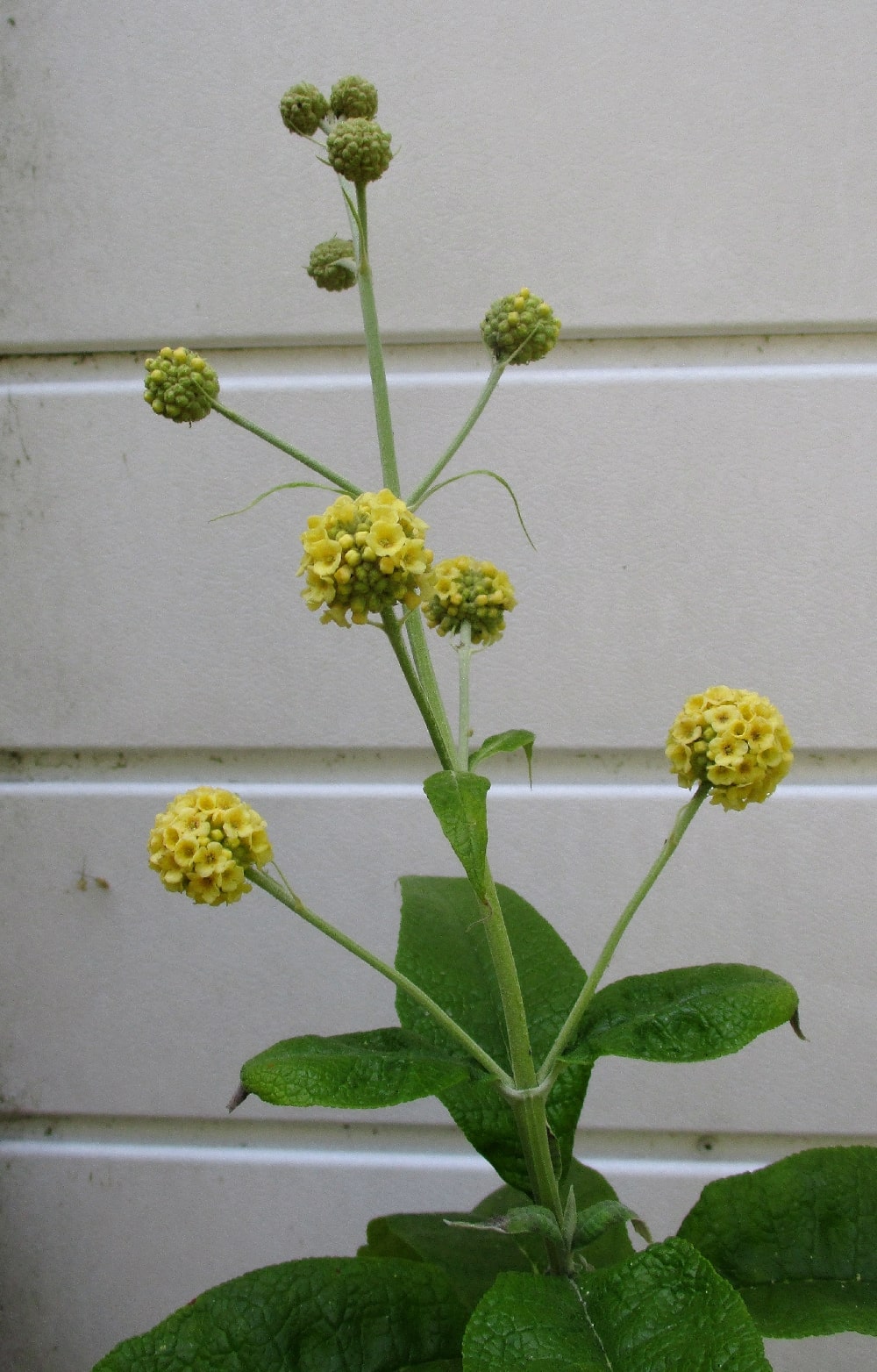
B. globosa 'Simon' has primrose-yellow flowers and the flower-balls are relatively large.
Open full size image in a new window
Buddleja x 'Longstock Gem'
25th May 2023
Buddleja x 'Longstock Gem' is a hybrid of B. crispa type: agathosma and B. alternifolia, bred by Peter Moore at the Longstock Park Nursery in Hampshire. The various B. crispa types hybridise quite readily with B. alternifolia, and B. x wardii is a naturally occurring hybrid of the two species reported from western China. 'Longstock Gem' is typical of these hybrids, which are intermediate between the parent species and usually likewise deciduous; as in B. x wardii, sometimes the glaucous foliage is alternate on the stem rather than opposite.
It is flowering now, a week or two after the spring-flowering B. crispa types, and a week or two before B. alternifolia. The flowers are a mid-purple, darker than either parent, and tend to be arranged in terminal paniculate cymes like B. crispa, rather than along the branchlets as in B. alternifolia.
I have been pleasantly surprised at just how hardy it has proven. It's one of those Buddlejas that forms its flower-buds in the autumn and holds them dormant over the winter, so it can lose all its flower-buds over a harsh winter. Despite the cold last December, this year 'Longstock Gem' is flowering well, although perhaps the inflorescences are a little smaller than usual, and it's already growing fast. Mine is quite a young plant, still less than 2 metres in height, but it has fully established and seems happy in its south-facing situation, which has good drainage and a rich soil.
Buddleja globosa TM 2954
24th May 2023
The choice of Buddleja globosa cultivars is quite limited, and there has been practically no selective breeding. New introductions do occasionally appear, usually raised from seed wild-collected in Chile. A while back, I was offered some seed from the B. globosa plants at the Hergest Croft garden in Herefordshire. The only information I have is a collection number, TM 2954, and the accession consists of both male and female specimens.
I have kept just one female plant from the seedlings I grew; a female because they are much rarer in cultivation than the male. A close up of the flowers shows they lack stamens and are thus described as pistillate. The leaves, buds and stems have a coppery tomentum, although in every other respect the plant is unlike the closely related B. araucana. I doubt I will ever get around to using the plant in selective breeding, but it's there if I need it.
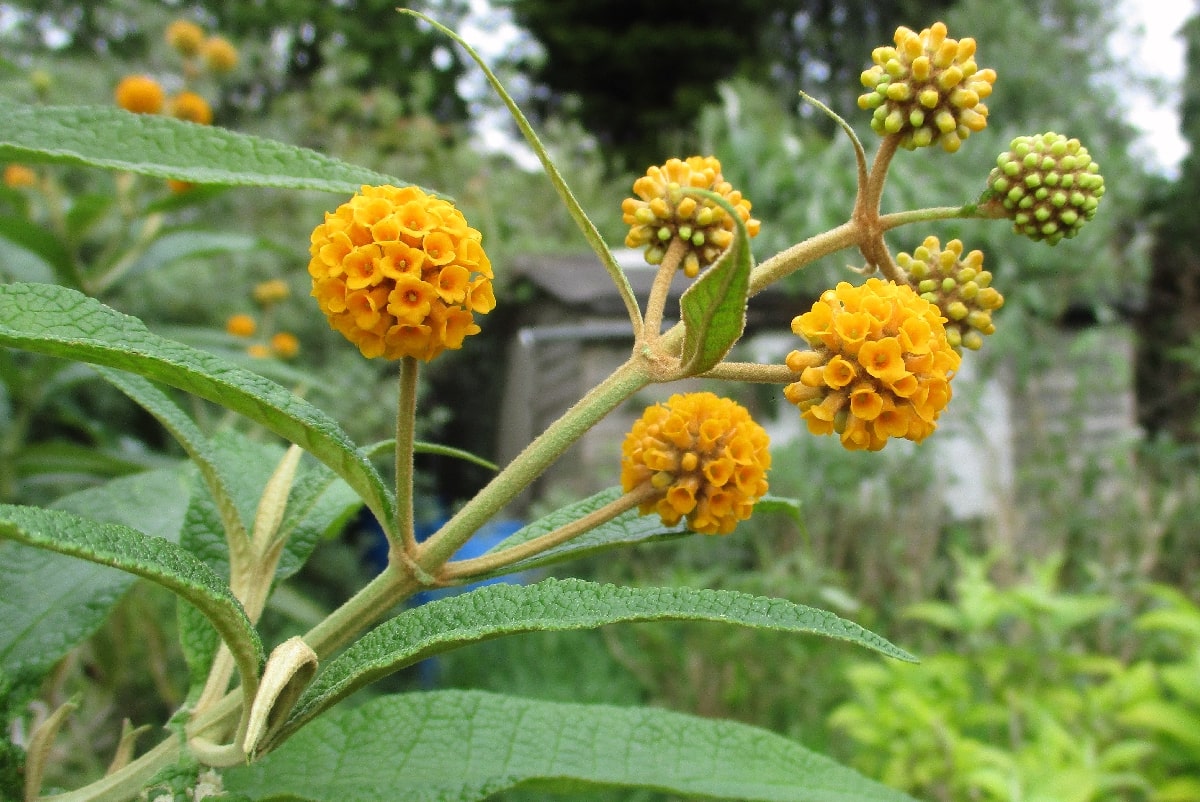
B. globosa TM 2954 (F2) has bright orange flowers and a coppery tomentum on the stems and buds
Open full size image in a new window
Never Say Die!
11th May 2023
The winter has claimed some victims from among the tender plants. Given how the temperatures were below freezing for over a week at a time in December, and that on the back of a drought through the summer, and a warm and wet autumn encouraging fresh growth, the damage has been lighter than expected.
Buddlejas have a reputation for being indestructible, although that just isn't true for many of the species and hybrids. But they are tenacious given half a chance. The plant shown is Buddleja macrostachya PAB 4198 from north-eastern India, a tall late-flowering example from the monsoon region. It flowered quite well in November last year. Then the frosts and the cold came, first killing the flowers and then the foliage. By January, it was bare wood. Peeling back the bark, it became clear the top growth had died.
Never say die, and come mid April the first signs of life appeared in the form of tiny green spots at the base. The buds have now started to break, and even if it grows only slowly, I will at least have some material to take cuttings. It was certainly worth waiting to see if the roots had survived, and several others I thought lost are doing the same.
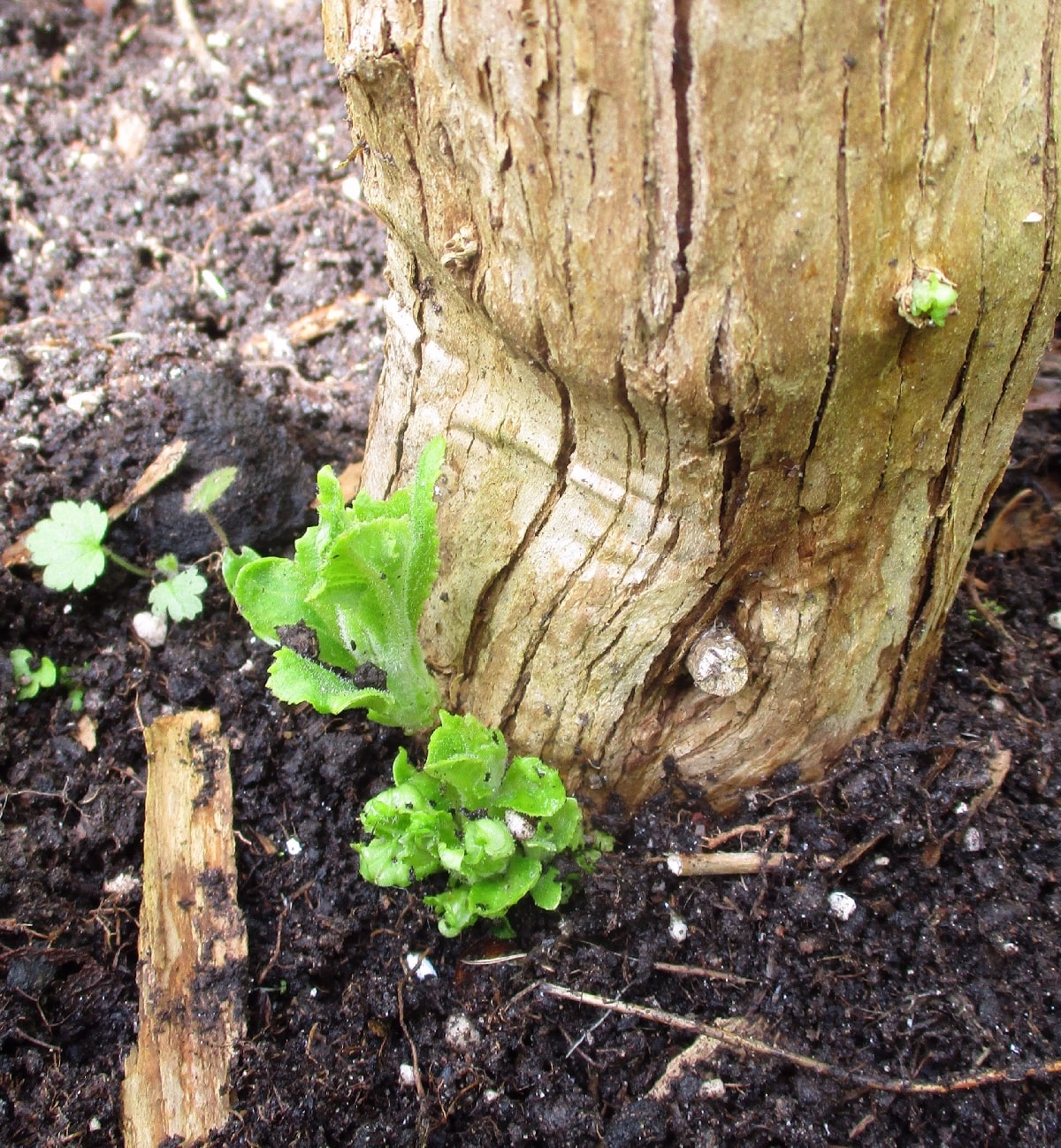
B. macrostachya PAB 4198 is throwing up shoots from the base, despite looking dead above.
Open full size image in a new window
B. salviifolia 'Alba'
5th April 2023
B. salviifolia is an African species with a wide range, all the way from the Equator to the Cape. Given its native habitat, the hardiness of this species is surprising. I have the blue-form growing quite happily outside; that one is probably from the Lake Malawi area, which has a much warmer climate than the UK. The white-flowered form has also proved hardy, and a plant I have in a 45 litre pot is now just too big to drag under cover for the winter. Despite the bitterly cold December, it has suffered no damage and is blooming now with huge panicles of delightfully scented flowers.
I'm confident enough now in its hardiness, I have another large plant in a pot I'll plant into the ground outside in a few weeks time, albeit in a sheltered position.
A Hard Winter
2nd April 2023
It's been quite a hard winter, with extended periods of freezing cold weather before Christmas. I have lost a few plants, although I'm not too worried about that as I have so many plants waiting in pots looking for somewhere to grow.
Hardiness is annoyingly unpredictable and growing positions just a few metres apart can vary in the level of shelter they afford plants. This can be different from year to year as the weather systems don't always approach from the same direction. Whether you position a tenderish plant in the right place for it to thrive can be down to luck, or at least dependent on a lucky guess.
Buddleja macrostachya is a variable species, and some are hardy and some are not - I'm fairly certain I've lost an autumn-flowering example to the cold. The summer-flowering ones are generally hardier, coming as they do from both higher altitude and greater latitude, and they grow more resilient with age. I've raised quite a few seedlings from crossing a couple of summer-flowering examples of this species and these have been a mixed bunch, and not always following their parents' example.
One particularly vigorous seedling has pink flowers and this has proven very hardy, much hardier than either of its white-flowered parents. As shown in the upper photo, this one has kept all its foliage over winter, despite the hard frosts and snow, and is already growing away eagerly. Right next to it on my plot is a white-flowered full-sibling, a somewhat less robust individual. This one has been reduced almost to bare branches, although it has clearly survived and is beginning to sprout again now.
While I'm here, I would like to mention that I have stripped all the advertising from the site and there are no annoying cookies to snoop on your browsing. Unlike many sites, there are none of those pointless scrolling adverts and no click-bait. But I do have to fund the cost of renting webspace, and the price has risen five-fold in a few years. So, if you have found The Buddleja Garden useful and informative, then please consider making a small contribution towards its costs via the Buy Me A Coffee logo or purple icon in the lower right-hand corner. Thank you.
If I cannot offset some of the cost, or find sponsorship, then it's unlikely the site will continue.
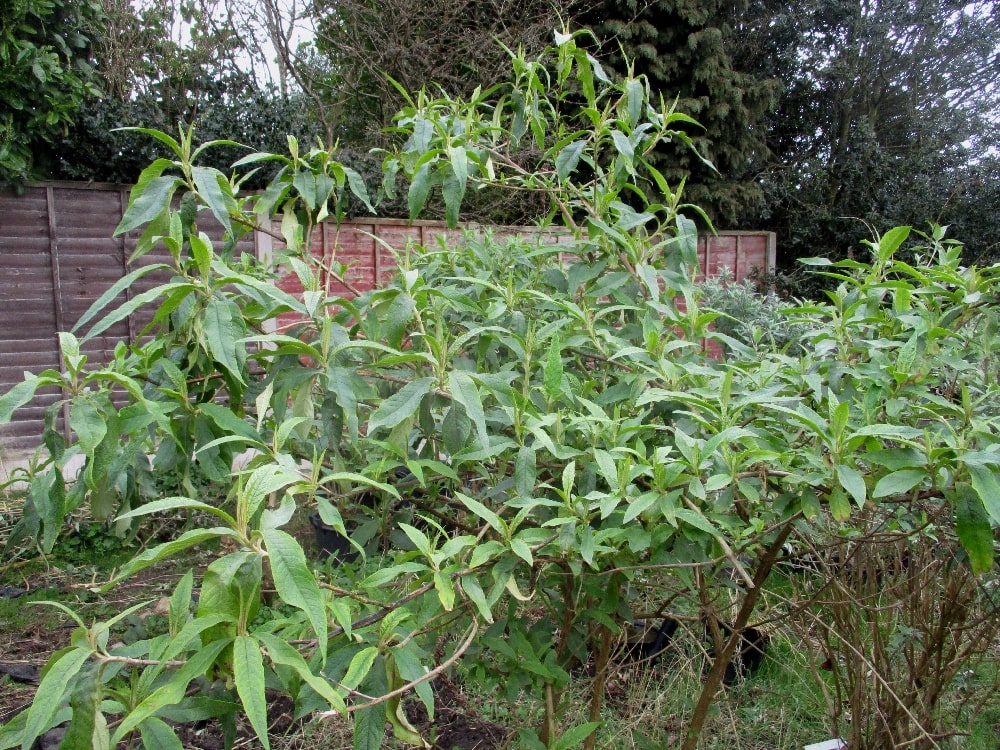
A B. macrostachya which has kept all its leaves over the winter and is already growing strongly.
Open full size image in a new window
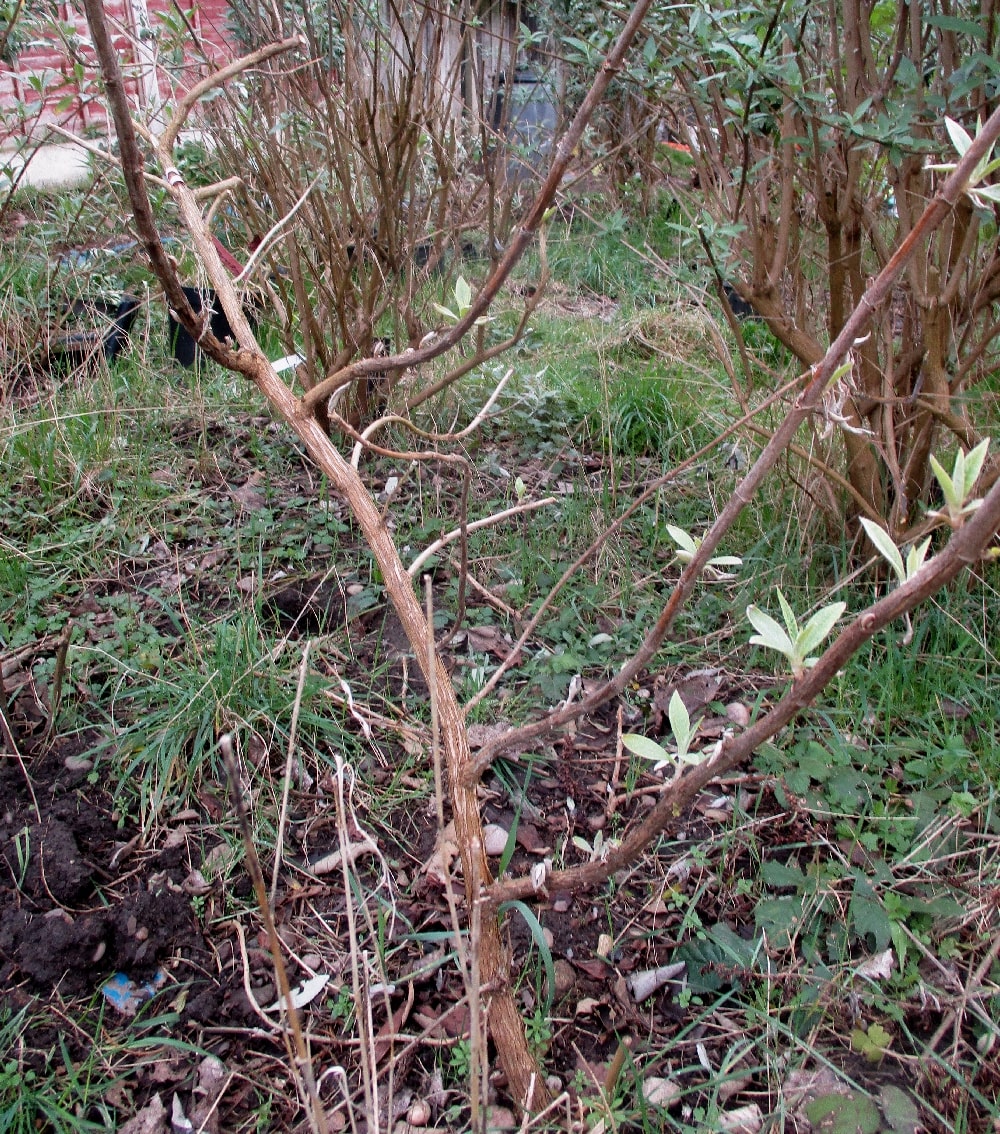
This B. macrostachya is a full sibling of the one above, but has been reduced almost to sticks.
Open full size image in a new window
Email:
buddlejagarden@gmail.com
© The Buddleja Garden 2011-2025.

